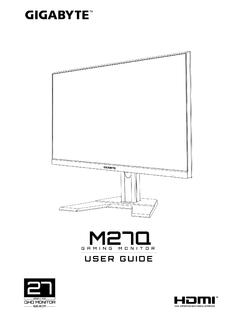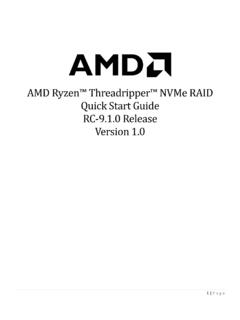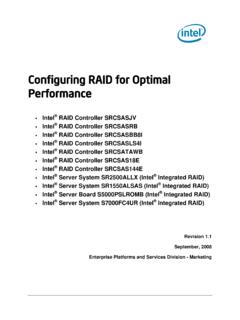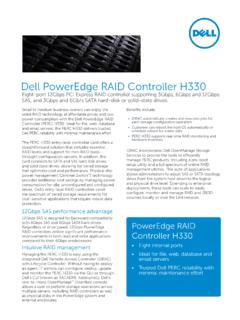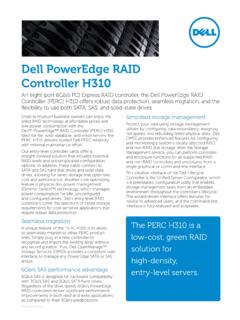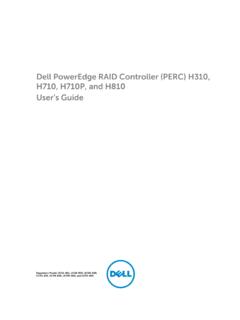Transcription of Configuring a RAID Set (X570 AORUS Series) - GIGABYTE
1 Configuring a RAID Set (X570 AORUS Series). RAID 1-1 Configuring SATA A. Installing SATA hard drive(s) in your 2. B. Configuring SATA controller mode in BIOS 3. C. UEFI RAID 3. 1-2 Installing the SATA RAID/AHCI Driver and Operating A. Installing Windows .. 7. B. Rebuilding an 8. -1- RAID Levels RAID 0 RAID 1 RAID 10. Minimum Number of 2 2 4. Hard Drives Array Capacity Number of hard drives * Size of the smallest drive (Number of hard drives/2) *. Size of the smallest drive Size of the smallest drive Fault Tolerance No Yes Yes To configure SATA hard drive(s), follow the steps below: A. Install hard drive(s) in your computer.
2 B. Configure SATA controller mode in BIOS Setup. C. Configure a RAID array in RAID BIOS (Note 1). D. Install the SATA RAID/AHCI driver and operating system Before you begin At least two SATA hard drives or SSDs (Note 2) (to ensure optimal performance, it is recommended that you use two hard drives with identical model and capacity). (Note 3). A Windows setup disk. Motherboard driver disk. A USB thumb drive. 1-1 Configuring SATA Controllers A. Installing SATA hard drive(s) in your computer Install the hard drives/SSDs in the connectors on the motherboard. Then connect the power connectors from your power supply to the hard drives.
3 (Note 1) Skip this step if you do not want to create RAID array on the SATA controller. (Note 2) An PCIe SSD cannot be used to set up a RAID set either with an SATA SSD or a SATA hard drive. (Note 3) Refer to "Internal Connectors," for the installation notices for the , and SATA connectors. -2- B. Configuring SATA controller mode in BIOS Setup Make sure to configure the SATA controller mode correctly in system BIOS Setup. Step: Turn on your computer and press <Delete> to enter BIOS Setup during the POST (Power-On Self-Test). Under Settings\IO Ports, set SATA Configuration\SATA Mode to RAID (Figure 1).
4 Then save the settings and restart your computer. (If you want to use NVMe PCIe SSDs to configure RAID, make sure to set NVMe RAID. mode to Enabled.). Figure 1. C. UEFI RAID Configuration Step 1: In BIOS Setup, go to Boot and set CSM Support to Disabled (Figure 2). Save the changes and exit BIOS Setup. Figure 2. The BIOS Setup menus described in this section may differ from the exact settings for your motherboard. The actual BIOS Setup menu options you will see shall depend on the motherboard you have and the BIOS version. -3- Step 2: After the system reboot, enter BIOS Setup again. Then enter the Settings\RAIDX pert2 Configuration Utility sub-menu (Figure 3).
5 Figure 3. Step 3: On the RAIDX pert2 Configuration Utility screen, press <Enter> on Array Management to enter the Create Array screen. Then, select a RAID level (Figure 4). RAID levels supported include RAID 0, RAID 1, and RAID. 10 (the selections available depend on the number of the hard drives being installed). Next, press <Enter> on Select Physical Disks to enter the Select Physical Disks screen. Figure 4. -4- Step 4: On the Select Physical Disks screen, select the hard drives to be included in the RAID array and set them to Enabled. Next, use the down arrow key to move to Apply Changes and press <Enter> (Figure 5).
6 Then return to the previous screen and set the Array Size, Array Size Unit, Read Cache Policy and Write Cache Policy. Figure 5. Step 5: After setting the capacity, move to Create Array and press <Enter> to begin. (Figure 6). Figure 6. -5- After completing, you'll be brought back to the Array Management screen. Under Manage Array Properties you can see the new RAID volume and information on RAID level, array name, array capacity, etc. (Figure 7). Figure 7. Delete RAID Volume To delete a RAID array, select the array to be deleted on the RAIDX pert2 Configuration Utility\Array Management\Delete Array screen.
7 Press <Enter> on Delete Array to enter the Delete screen. Then set Confirm to Enabled and press <Enter> on Yes (Figure 8). Figure 8. -6- 1-2 Installing the SATA RAID/AHCI Driver and Operating System With the correct BIOS settings, you are ready to install the operating system. A. Installing Windows As some operating systems already include SATA RAID/AHCI driver, you do not need to install separate RAID/. AHCI driver during the Windows installation process. After the operating system is installed, we recommend that you install all required drivers from the motherboard driver disk using "Xpress Install" to ensure system performance and compatibility.
8 If the operating system to be installed requires that you provide additional SATA. RAID/AHCI driver during the OS installation process, please refer to the steps below: Step 1: Copy the Hw10 folder under the \BootDrv folder in the driver disk to your USB thumb drive. Step 2: Boot from the Windows setup disk and perform standard OS installation steps. When the screen requesting you to load the driver appears, select Browse. Step 3: Insert the USB thumb drive and then browse to the location of the driver. The location of the driver is as follows: Windows 64-bit: \Hw10\RAID\x64. Step 4: When a screen as shown in Figure 1 appears, select AMD-RAID Bottom Device first and click Next to load the driver.
9 Then select AMD-RAID Controller and click Next to load the driver. Finally, continue the OS installation. Figure 1. -7- B. Rebuilding an Array Rebuilding is the process of restoring data to a hard drive from other drives in the array. Rebuilding applies only to fault-tolerant arrays such as RAID 1 and RAID 10 arrays. To replace the old drive, make sure to use a new drive of equal or greater capacity. The procedures below assume a new drive is added to replace a failed drive to rebuild a RAID 1 array. While in the operating system, make sure the Chipset and RAID drivers have been installed from the motherboard driver disk.
10 Then double-click the RAIDX pert2 icon on the desktop to launch the RAID utility. Step 1: Step 2: Enter the login ID and password (default: "admin"), In the Disk Devices section, left-click your mouse and then click Submit to launch AMD RAIDX pert2. twice on the newly-added hard drive. Step 3: Step 4: On the next screen, select Assign as Global Spare During the rebuild process, you can select the array and click Confirm. that is being built (displayed in red) in the Active Volumes section to check the current progress. Step 5: Then rebuild is complete when the Task State column shows "COMPLETED.









